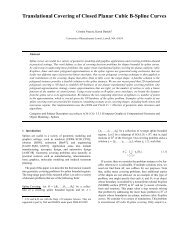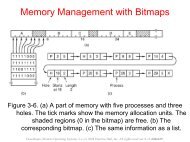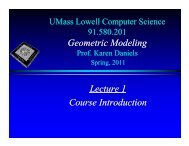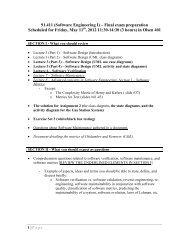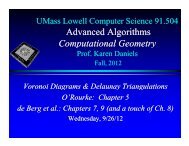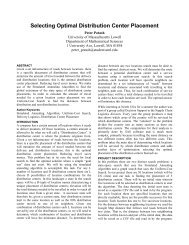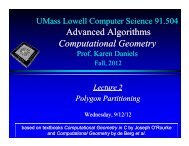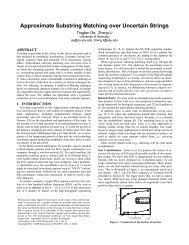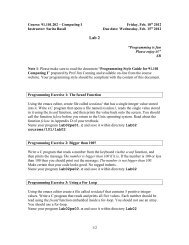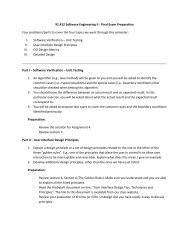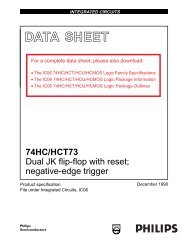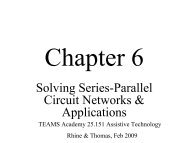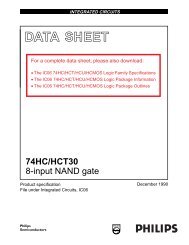SIGCHI Conference Paper Format - Computer Science - University ...
SIGCHI Conference Paper Format - Computer Science - University ...
SIGCHI Conference Paper Format - Computer Science - University ...
Create successful ePaper yourself
Turn your PDF publications into a flip-book with our unique Google optimized e-Paper software.
Intelligent Ground Vehicle Competition – JAUS Challenge<br />
Entry 2012<br />
ABSTRACT<br />
In this paper, the Joint Architecture for Unmanned Systems<br />
(JAUS) implementation designed to work with the Robot<br />
Operating System (ROS) and run on the <strong>University</strong> of<br />
Massachusetts – Lowell's robot (“Stark”) is described. An<br />
overview of the implementation utilizing the open source<br />
JAUS++ library is given. This includes a brief overview of<br />
the JAUS standard and the Intelligent Ground Vehicle<br />
Competition requirements, which are subset of the complete<br />
JAUS standard. The ROS side of the implementation is<br />
also discussed, as the implementation functions as a ROS<br />
node.<br />
Author Keywords<br />
Interoperability, JAUS, ROS, IGVC.<br />
INTRODUCTION<br />
One of the challenges for this year's entry in the IGVC is<br />
the implementation of JAUS on the <strong>University</strong>'s robot,<br />
“Stark.” This project represents the attempt to fulfill that<br />
requirement. As it has been decided upon to use ROS as a<br />
framework for the entire system running on the robot, the<br />
goal was to produce a working ROS node which provides<br />
all of the JAUS functionality required by the rules of the<br />
IGVC. In order to test this functionality, the project also<br />
included a JAUS test program based on the description<br />
given in the IGVC rules. This test program is outside of<br />
ROS and may be used to test the ROS node and it's<br />
implementation of the required JAUS interface. This work<br />
builds on previous work to increase standards compliance<br />
in unmanned systems [2].<br />
PROJECT DESCRIPTION<br />
What was developed for this project was essentially two<br />
pieces of software, both intended to run on Linux systems.<br />
First and foremost was the main interface layer between<br />
ROS and JAUS. This was developed using the open source<br />
Christopher D. Granz<br />
<strong>University</strong> of Massachusetts – Lowell<br />
1 <strong>University</strong> Ave. Lowell, MA 01854<br />
chrisgranz@gmail.com<br />
978-473-3712<br />
JAUS C++ library JAUS++. This greatly facilitated the<br />
implementation of this software by allowing the<br />
development of the actual interface to be focused on.<br />
In order to test the main component of the project, a second<br />
piece of software developed as a stand-in for what the<br />
judges' at the competition will be using to test the JAUS<br />
interface of the robot (the JAUS-ROS node of this project).<br />
This was designed based on the requirements given in the<br />
IGVC rules.<br />
JAUS is an important standard developed and supported<br />
mainly by the Department of Defense [1], and has found its<br />
way into the private research and academic communities<br />
(although not overwhelmingly.) In some ways, JAUS is an<br />
alternative to ROS, but it does not provide an actual code<br />
base to work from like ROS, but rather simply a standard<br />
which must be implemented.<br />
An initial effort was made on the part of the author to<br />
implement the JAUS standard directly using the standard<br />
Linux socket API. This proved to be very time-consuming<br />
and unnecessary with the discovery of the JAUS++ library.<br />
This is a fairly straightforward library to use with tutorials<br />
available on using the API.<br />
Permission to make digital or hard copies of all or part of this work for<br />
personal or classroom use is granted without fee provided that copies are<br />
not made or distributed for profit or commercial advantage and that copies<br />
bear this notice and the full citation on the first page. To copy otherwise,<br />
or republish, to post on servers or to redistribute to lists, requires prior<br />
specific permission and/or a fee.<br />
Figure 1. High-level system architecture.
A high-level system diagram is shown in Figure 1. The<br />
blocks labeled “JAUS-ROS Node” and “JAUS Test Tool”<br />
are the software created as part of this project. The block<br />
labeled “All ROS Nodes running on 'Stark.'” represents the<br />
rest of the system (ROS nodes) which complete the<br />
<strong>University</strong>'s 2012 IGVC entry. The block labeled “IGVC<br />
Judges' JAUS System” is the unknown test program used<br />
by the IGVC judges to evaluate the <strong>University</strong>'s 2012 entry.<br />
JAUS is built around UDP and message passing [2] and<br />
requires the implementation of “services” provided by<br />
“components”. The main service is the Management<br />
Component, which is what allows high-level control of a<br />
robotic system. This component allows the robot to be<br />
stopped/resumed and shutdown. In addition to this, Sensor<br />
Components, which provide readings and data about a<br />
robotic system are generally created. Each component is<br />
essentially discovered initially by the outside control<br />
system, and then data may be requested of it, or commands<br />
sent to it.<br />
In addition to the Management Component and Sensor<br />
Components, the IGVC Challenge requires what is known<br />
as a Local Way-point List Driver Component be<br />
implemented. The service that this component provides is<br />
the ability to set a list of way-points and the then have the<br />
robot execute the list by driving to each way-point<br />
sequentially.<br />
The structure of these components and the discovery and<br />
UDP communication is handled by the JAUS++ library. To<br />
implement special functionality and handling way-point list<br />
messages, special classes can be created which are child<br />
classes of the JAUS++ library classes. This is done in this<br />
project for the Local Way-point List Driver JAUS<br />
component, but is merely a stub because the ROS<br />
architecture to be used has not yet been defined.<br />
ANALYSIS OF RESULTS<br />
To analyze the correctness of the implementation the results<br />
of running the JAUS-ROS node and communicating with it<br />
via the created JAUS test program was compared to the<br />
specifications given in the IGVC rules for the JAUS<br />
challenge. The ROS core software was run in the<br />
background with the standard ROS simulation known as<br />
stage and a simple ROS node which drives a robot around a<br />
track running. As the ROS architecture for the real robot is<br />
not completed at the time of this writing, this simulation<br />
acted as the ROS side of the system.<br />
The results of this simulation were compared with those<br />
given in the IGVC JAUS Challenge rules and in particular<br />
the communication diagram shown in Figure 2.<br />
In this diagram, what is labeled “COP” (for Common<br />
Operating Picture) on the left represents the judges' JAUS<br />
implementation. What is labeled “Entry” on the right<br />
represents the JAUS-ROS node developed for the project.<br />
Figure 2. Communication Diagram.<br />
The software created for this project meets the requirements<br />
as far as this author can tell. The main issue remaining is<br />
tying some of ROS side connections into the ROS<br />
architecture which has not yet been implemented by other<br />
individuals.<br />
DISCUSSION<br />
Although standards are invaluable for interoperability of<br />
unmanned systems, this author found JAUS to be<br />
unnecessarily complex, although it may simply be that it<br />
includes much more than is required for the IGVC<br />
challenge. The lack of a reference implementation makes<br />
the JAUS documentation seem even more convoluted.<br />
Even with the complexity of the standard some have found<br />
it not sufficient for their purposes and have chosen to<br />
extend it [3]. This essentially negates the whole purpose of<br />
a standard in the first place.<br />
This project was an important part of the <strong>University</strong>'s 2012<br />
IGVC entry project which has been developed by several<br />
researchers, and will hopefully result in a higher score at<br />
the competition. In hind-sight, this author may have chosen<br />
a different project to devote time to, as this turned out to be<br />
very frustrating and not terribly interesting or innovative.<br />
As a necessary interface layer this project has value, and<br />
may be used as the basis for future entries in the IGVC by<br />
the <strong>University</strong>'s team.<br />
CONCLUSIONS<br />
The author believes the project was a success, even if not<br />
glamorous to an outside observer. This was a project<br />
completed primarily out of necessity, not new research. It<br />
will be interesting to see what the future of the JAUS<br />
standard holds, as this author believes it may be replaced by
more popular systems, such as ROS, that have an open<br />
source code base to work from. None of the functionality<br />
defined by the JAUS standard cannot be provided directly<br />
by ROS, and the support for JAUS seems to be somewhat<br />
lacking in practice, based simply on research of<br />
publications related to JAUS by this author.<br />
In future work, it may be helpful to implement a visual<br />
JAUS testing tool, perhaps which is cross-platform and<br />
does not use the JAUS++ library. By developing this type<br />
of testing tool, future IGVC entries can be appropriately<br />
tested and more quickly than the simple terminal based test<br />
program created as part of this project.<br />
ACKNOWLEDGMENTS<br />
The work described in this paper was conducted as part of a<br />
Spring 2012 robotics course, taught in the <strong>Computer</strong><br />
<strong>Science</strong> department of the <strong>University</strong> of Massachusetts<br />
Lowell by Prof. Fred Martin.<br />
REFERENCES<br />
1. Huang, H., Albus, J., Kotora, J., and Liu, R.<br />
Robotic Architecture Standards Framework in the<br />
Defense Domain. In Proc. IEEE/RSJ International<br />
<strong>Conference</strong> on Intelligent Robots and Systems 2003.<br />
2. Pacis, E.B., Everett, H.R., Farrington, H., Kogut,<br />
G., Sights, B., Kramer, T., Thompson, M., Bruemmer, D.,<br />
and Few, D. Transitioning Unmanned Ground Vehicle<br />
Research Technologies. In Proc. SPIE 2005, Volume<br />
5804, pp. 521-531 (2005).<br />
3. Touchton, R., Kent, D., Galluzzo, T., Crane III, C.<br />
D., Armstrong II, D. G., Flann, N., Wit, J., Adsit, P.<br />
Planning and modeling extensions to the Joint<br />
Architecture for Unmanned Systems (JAUS) for<br />
application to unmanned ground vehicles. In SPIE<br />
Defense and Security Symposium 2005.




